How To Play Great Fingerpicking Guitar--Even If You're
All Thumbs!
Chapter 13
DAVE VAN RONK--NEW YORK PIZZAZZ
Any trouble with the tablature below? Go To Chapter 3
Dave Van Ronk was one of my major guitar teachers. The first time I went up to
his Greenwich
Village apartment for a guitar lesson, I remember seeing row after row of
records, each meticulously catalogued and categorized
in accurately labelled wall-to-wall shelves. It was a little like living in a
"record store with furniture." Really neat!
A lesson with Dave was a cultural experience as well. Songwriters, musicians,
and other
Village notables would drop by. During these interruptions I would slyly check
out some
of the record shelving. I'd find everything from dixieland, bebop, assorted
oddities, and,
of course, old blues, ragtime, and field recordings of American and world folk
music.
Dave's tremendous jazz knowledge and unique intelligence made him a
great sage--and a terrific arranger for the steel-string guitar. His mind
excelled at
positioning chord inversions and sequences up and down the neck. I based my
guitar
arranging concepts on his approach.
As I recall, Van Ronk was also one of the earliest--if not the first--Sixties
guitarist to rearrange "piano roll" and ragtime music for the guitar.
I remember coming over for a lesson and watching him arranging Jelly Roll
Morton's lengthy
St. Louis Tickle piano rag (using an LP on Riverside Records). It had several
sections, each one
with its own finger-bending challenges. When New York folkies and guitarists
everywhere started hearing Dave's audacious guitar arrangement, it had a huge
influence. It was also a real monster to play!
Fortunately, Van Ronk also delighted in creating simple but precise arrangements
of old
jazz-flavored songs and blues for the guitar. Here are a few of them.
CARELESS LOVE
Hear The Music
This is one of the most famous tunes in American popular music. Dave's
arrangement
turns it into a really swingin' blues--almost "Classic Blues" (Bessie
Smith, et. al.) in its
feel.
Van Ronk pointed me to an compilation of early blues on LP by musicologist Sam
Charters--titled The Country Blues (on a subsidiary of Folkways
Records--"RBF"--originally
designed for research). Lonnie Johnson's incredible version of Careless Love was
on this
record (and I could never listen to Burl Ives or Richard Dyer Bennett sing this
song
again!). Dave's arrangement is an interesting blend of Jimmy Yancy- style blues
piano
licks with guitar licks in the Lightnin' Hopkins/Mance Lipscomb mold.
Check it out!
The piece starts out with an E7 position derived from sliding the normal D7 chord
up two
frets. But play it with your Ring on the 3rd string and Pinky on the 1st
string:

Measure 1:
Beat 1: Slide Ring and Pinky up from second to fourth fret on the 3rd
and 1st strings, respectively.
Beat 2: Play this bass note by fretting the 6th string with your MIDDLE
finger, fourth fret.
Beat 3: Just an open bass
Beat 4: Index on 5th string first fret. Play this together with OPEN 3rd and 1st
strings.
The politically correct name for this chord is an "E diminished," if
you really must know.
Measure 2:
Beat 1: Slide that Index on the 5th string up one more fret! Now place your
Pinky on the
2nd string fourth fret, play these two notes.
Off-beat: Put your Ring on the 3rd string fourth fret and play it. Call this
Another B.
Beat 2: Drop off the Index and play the 5th string open, as your remove the rest
of the chord...and place your fingers on the...
Beats 3 & 4: Middle on the 6th, Ring on the 3rd, Pinky on the 1st strings.
All on same fret.
This position will be used a lot in this tune (and in other songs with harmonized
sixths in the key of E). Slide it up to the fourth fret, then down...
Here's what this position looks like:
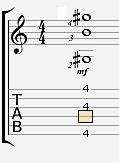
The fingers move together up and down the neck, staying on the same
fret.
Measures 3 and 4:
Still this same position for most of these two measures! Even though you're not
playing the
three strings at the same time, together, keep Middle on 6th, Ring on 3rd,
and Pinky
on 1st string, same fret.
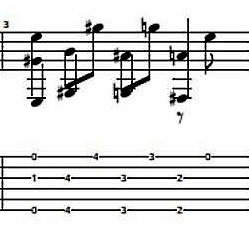
Measure 3:
Beat 1: Start with one finger of the normal E chord, play the three
strings.
Beat 2: Make the position from end of Measure 3 by sliding Middle (6th
string) and Ring (3rd string) up from about the second to the fourth frets.
Off-beat: Place Pinky on 1st string (same fret as the other fingers). Play
it.
Beat 3: Move this form down one fret, play 6th and 3rd strings
together, then 1st string.
Beat 4: Move form down to second fret, play 6th and 3rd strings
together, then 1st string.

Measure 4:
Beat 1: Start with one finger of the normal E chord, play 6th and 3rd
strings.
Off-beat: Play 1st string open.
Beat 2: Make the position again now with 6th string and 3rd string on
second fret. However, leave off pinky. Off-beat: Open 1st string.
Beat 3: Up one to third fret, otherwise same as Beat 2.
Beat 4: Up one to fourth fret, but same as Beat 3.
Measure 5 and 6 take the Middle off the 6th string and play it open.
But the Ring and Pinky still usually play the 3rd and 1st strings:
Measure 5 and Measure 6
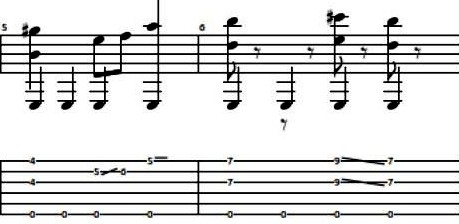
Measure 5:
Beat 1: Slide Ring and Pinky up to fourth fret on 3rd string, while playing open
6th string bass.
Beat 2: Open bass again, solo.
Beat 3:Open bass again. Off-beat: Middle on 3rd string, slide up one or two
frets to sixth fret.
Beat 4: [While leaving Middle on third string] Index on 1st string fifth fret.
Play simultaneously with bass.
Measure 6:
Beat 1: Place Ring on 3rd, Pinky on 1st strings again and slide up to seventh
fret. Play open bass simultaneously.
Beat 2: Merely bass note.
Beat 3: Slide the whole mess from Beat 1 up two more frets, with open bass.
Resist the urge to go have a beer; the hard stuff is almost over.
Beat 4: Slide the two back down to the seventh fret, with bass.
Two Types of B7 Measure 7 and
Measure 8
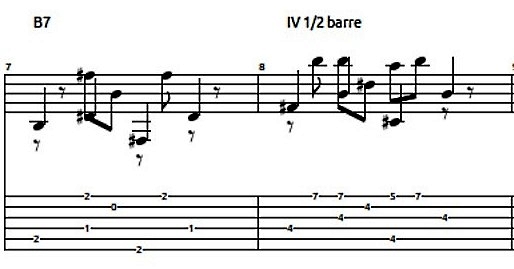
Measure 7: This is a basic B7 measure. Note the alternate bass.
Measure 8: This is the Full A moved up two frets.
Barre four strings on the fourth fret
with Index, and put Pinky on the 1st string seventh fret.
Alternate basses are 4th & 3rd strings.
Beat 1: Play 4th string (one of the barred notes). Off-beat: play the 1st string
with Pinky.
Beat 2: 1st and 3rd string together. Off-beat: 2nd string.
Beat 3: Middle on 1st string, fifth fret, together with bass. Off-beat: Take off
Middle, put
Pinky back on seventh fret.
Beat 4: Alternate Bass again, on alternate string (the 3rd).
This higher B7 is very useful. Broonzy used it a lot. So do I!
Measures 9 & 10 = Measures 5 & 6.
Careless Love Measures 11 and 12

Measure 11:
Beat 1: Make a simple A7 (Mance Lipscomb-style) and
slide it up from the first to the second fret--while playing the 2nd and 5th
strings.
Off-beat: Open 1st string.
Beat 2: Normal A7 notes here, alternate bass.
Beat 3: Pinky on third fret, 1st string. Play it with the bass. Off-beat: 1st
string open (no pinky).
Beat 4: Play alternate bass. Off-beat: Yikes! Slide Ring up to fifth fret, 2nd
string and start to make the Lightnin'
Hopkins A blues position (we learned it, remember?).
Measure 12:
Beat 1: Yet, this sure is the Hopkins A Blues lick position, all right. That is,
Index on 1st
string third fret, Ring two frets higher on 2nd string. Play 1st and fifth
strings.
Off-beat: Play 2nd string.
Beat 2: 1st and 5th strings. Off-beat: add Pinky to fifth fret, 1st string.
Play it.
Beat 3: Bass alone. Off-beat: Index on third fret 1st string (Remove
Pinky!).
Beat 4: Bass on 5th string together with Ring on 2nd string, fifth fret.
All of Measure 12 is played with this
Hopkins blues A chord form.
The rest of the piece virtually repeats the first four measures, with only the
last measure as a simple ending, with a simple hammer-on.
You're gonna love this arrangement!
It moves all around the neck without being a pain in the neck. Sounds great,
too.
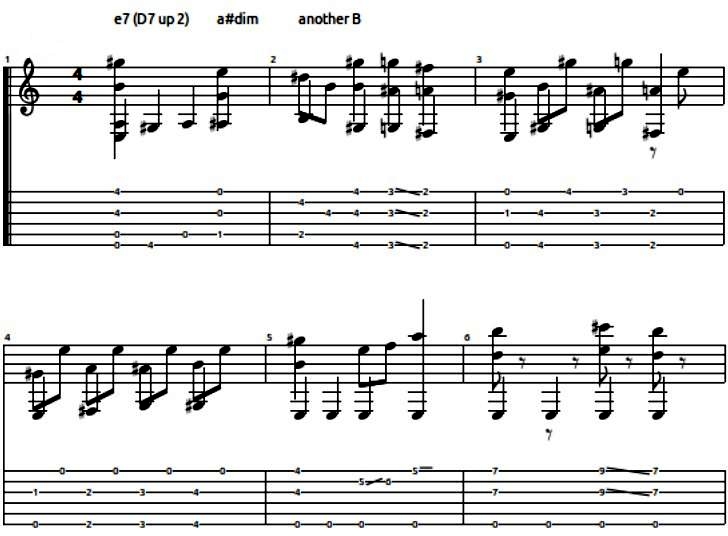

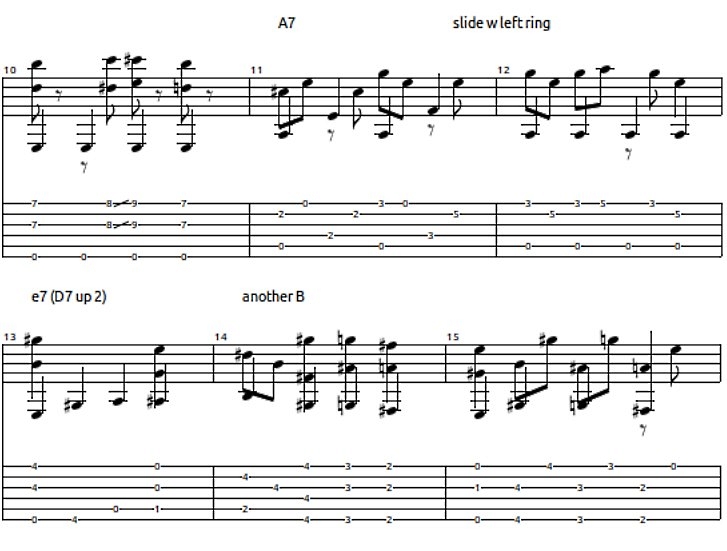

GEORGIE AND THE IRT--6/4 TIME
Hear The Music
Now for this book's weirdest digression. This piece is a parody on the
Carter Family's historically important (and great to listen to) "Wreck Of
The FFV."
This early 1960s version chronicles the travails of a Brooklyn shipping
clerk trying to get home on the New York City subway system during the Friday
evening rush
hour.
He didn't make it.
For those of you who know New York, listen to the tape for the lyrics.
They're as funny (and accurate!) today as they were thirty years ago. Ah
well..........
The original classic country song detailed a train wreck down South.
But more important--it's in Waltz Time.
You have a legal right to know that not all fingerpicking music is in
4/4 time, with four beats per measure (each bass note getting one beat).
Waltz time music is in measures of THREE beats, or multiples
of three
beats.
- This means you count: 1......2......3......,
- then start over again at the next measure, and count:
1......2......3......again.
Many fingerpicking pieces in Waltz Time are more easily written down
with SIX beats per measure, or:
1.....2.....3.....4.....5.....6.....(then repeat)
Thus I've written this tune in 6/4.
Don't worry, all this means is:
Count 6 even beats per measure, then do it again.
In order to get our feet wet playing this Waltz meter, let's look at the first
two measures:

Measure 1:
Beat 1: Make a C chord, and play the first beat by simultaneously
plucking the 5th and 2nd strings together.,br>
Beat 2: Hit the 4th string bass.
Beat 3: Hit the 4th string bass again.
Beat 4: Move Ring to the alternate bass for C, the 6th string. Play
together with 2nd
string.
Beat 5: Hit the 4th string. Off-beat: Pinky on 2nd string, third fret.
Play it.
This is a syncopation, so it's supposed to confuse you a little.
Beat 6: Hit the 4th string bass again.
So you hit SIX bass notes. Not hard when you get used to it.
Measure 2:
Beat 1: 1st and 5th strings together.
Beat 2: 4th string alternate bass. Off-beat: 1st string solo.
Beat 3: Just alternate bass.
Beat 4: Ring to 6th string. Pinch 6th and 1st string simultaneously.
Beat 5: Alternate bass, solo.
Beat 6: Pinky on 2nd string third fret. Play simultaneously with
alternate bass (4th string).
Again, the count is ONE TWO THREE, FOUR FIVE SIX
Emphazise the ONE and FOUR. They're the "strong beats."
Measure 3 goes to the F chord with your Left Thumb brought over the back
again:
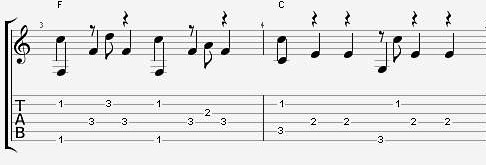
Measure 3:
Beat 1: 6th and 2nd string together
Beat 2: Alternate bass on 4th string. Off-beat: Pinky on 2nd string third fret.
Play it.
Beat 3: Hit the 4th string bass again.
Beat 4: 6th and 2nd string together.
Beat 5: Alternate bass on 4th string. Off-beat: Play 3rd string.
Beat 6: Hit the 4th string bass again.
Measure 4:
Beat 1: 5th and 2nd strings together on this C chord.
Beats 2 & 3: Hit the alternate bass again (twice).
Beat 4: Alternate bass to 6th string. Off-beat: 2nd string.
Beats 5 & 6: Alternate Bass on 4th string (twice).
Measure 5 & 6:
Measure 5:

Beats 1, 2, and 3 are an F chord. Beats 4, 5, and 6 are on a D9 chord
(See Saturday Night Shuffle). This means the 4th string is now open.
Measure 6:

A G chord. The second half of this measure is a Bass Run from G to C.
Let go of the chord and play the notes individually.
Now Measures Seven and Eight

More C chord notes. Pretty straight forward. But note that your pinky goes on
and off
the 1st string third fret. Keep those Zeroes and Threes separate!
The rest of the piece is repeating the above--or very similar. Try to keep a
Waltz feel
with the bass, and all else will follow!
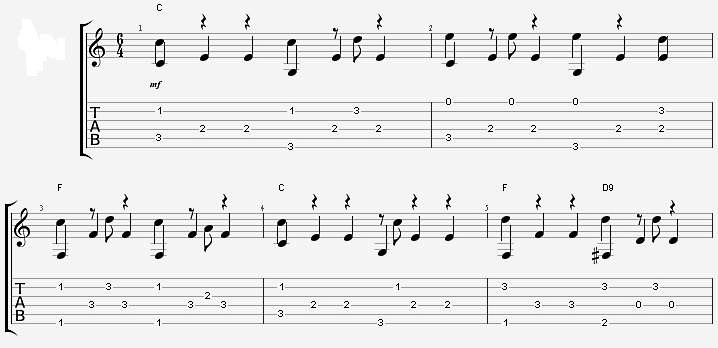
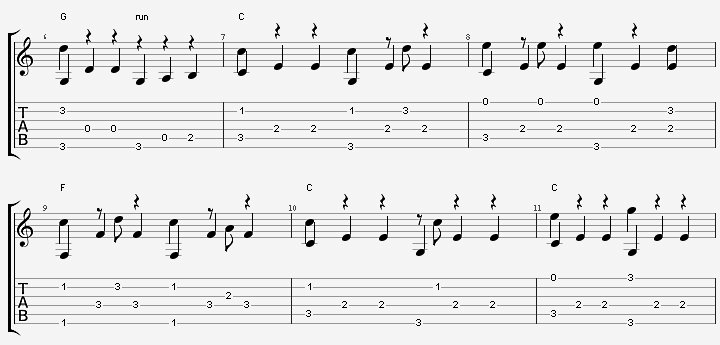



COME BACK BABY
Listen Up
This is one of Van Ronk's most famous arrangements. I remember walking
into Dave's apartment for a lesson once when he showed me an album by Snooks
Eaglin, a New Orleans blues/R&B guitarist and singer. He then played me Eaglin's
powerful version of Come Back Baby--a brooding, Hopkins-style blues in A.
Some time later Dave recorded his own masterful arrangement. It blends
the Hopkins Blues style with Dave's own subtle harmonic touch and concise blues
phrasing. I've played it ever since. This arrangement is really a classic!
We're counting triplets again here (see the Lightnin' Hopkins chapter,
earlier).
Measure 1:
+---+ +-----+ +------+ +---+ +---+ +------+
+ + + + + + + + + + + + + +
+---+---+--3--+--3-----+-sl+--5---+---+-|+sl-+---9-I-+--9-------+
+---+--M+--+--+--+--+--+___+--+---+---+-|+___10--+---10-+-------+
+---+---4--+--4--+--+--5---6--+---+---+-|+---+M--+------+-------+
+---+---+--+-----+--+--+------+---+---+-|+---+---+------+-------+
+---0---0--0-----0--+--0------0---0---0-|0---0---0------0-------+
+---------------------------------------|-----------------------+
Start off this piece before Measure 1 with a half-measure of harmonized sixths
(a la
Careless Love Blues):
Middle finger on 3rd string 4th fret, Index on 1st string third fret.
Use this position:
Fret+--------------+
+--+--+--+--+--+
+--+--+--+--+--+
3 +--+--+--+--+--I
+--+--+--M--+--+
5 +--------------+
Measure 1:
Beat 1: Now place the Middle up one fret on the fifth fret, and play it with the
bass.
Immediately slide it up to the sixth fret. On the last part of the triplet, play
the bass
together with the 1st string (now fretted on the fifth fret).
Beat 2: Bassnotes of the triplet.
Beat 3: Start with first triplet bass note. Then put Middle on 2nd string, and
(while sliding
up to the tenth fret) play it with last triplet bass note.
Beat 4: Index on 1st string ninth fret, play with bass note. Then 2nd string
alone. Then
1st string again with last bassnote of triplet.
Measure 2: Measure 3:
Full A D9
+---+ +-----+ +----+ +----+ +----+ +--+ +--+ +---+
+ + + + + + + + + + + + + + + + + +
+--7---+----+--7--+-|-+----5--5--3-+-----0--+-+-+--+--+--+-wh--++
+--8---+----+--8--+-|-+----+--+----5--+--+--3-+-+--+--+--+-3---1+
+--+---+----+-----+-|-+----+--+----+--+--+----+-+--+--+--2-+---++
+--+---+----+-----+-|-+----+--+----+--+--+----+-+--+--+--+-+---++
+--0---0----0-----0-|-0----0--0----0--+--+----+-+--+--+--+-+---++
+-------------------|--------------------2----2-2--2--2--2-2---2+
Measure 2:
Beat 1: Slide down the Index and Middle two frets (to seventh and
eighth frets). Play with bass.
Beat 2: Play these again, but in the MIDDLE of the triplet. Basses are
alone.
Beat 3: Now make a Full A chord (from Spoonful). Play Pinky on the 1st
string fifth fret together with the last triplet bassnote.
Beat 4: Pinky and bass together, then remove Pinky, add Middle to 1st
string third fret. Then Pinky on 2nd string fifth fret, together with last
bassnote
triplet.
Measure 3:
Beat 1: Make a D9 chord Play bass on 6th string
together with open
1st string. Then Ring on 2nd string third fret. Last bassnote triplet is played
solo.
Beat 2: Bassnotes
Beat 3: Bass on first triplet, then last triplet bassnote together with
3rd string.
Beat 4: Bassnote together with RING on 2nd string third fret. WHINE
the heck out of this Ring!
Pull towards the center of the guitar neck on the first beat.
On the middle of the triplet pull Ring back to the "normal" note, but
keep it ringing. This
gives you two notes with one pull. Very Bluesy. On the last third of this beat
remove Ring, play first fret with the
Index (together with last triplet bass).
Measure 4: Measure 5:
F [Hopkins Blues Lick]
+---+ +----+ +----+ +-----+ +-----+ +--+ +----+ +---+
+-+---+---+--+-+--+----+--+--+--+----sl---+-+-+--+-+--+-+-+-+-+-+
+-+---+---+--+-1--+----+--+--1--3--+___---8-+-+--+-+-10-+10-8-+-+
+-2---+---+--2-+--+----2--2-----+--+--9-----+-+--+-+----+-+---9-+
+-+---+---+----+--+----+--+-----+--+M-+---I-+-+--+-+--R-+-+---+-+
+-+---+---+----+--+----+--+-----+--+--0-----0-0--0-0----0-0---0-+
+-1---1---1----1--1----1--1-----1-------------------------------+
Measure 4: F chord here, with thumb. This is straight-forward.
Measure 5: Now place Middle on the 3rd string, and SLIDE it up to the
ninth fret.
Beat 1: As you start the slide, hit the 5th string bass. Then place
Index on the 2nd string and play it. Solo bass note completes the triplet.
Beat 2: Just bass. BUT LEAVE the two fingers on the 3rd and 2nd strings.
Beat 3: Start with a bass. Middle of the triplet--place Ring on 2nd string tenth
fret and
play it. Then solo bass completes the triplet.
Beat 4: Ring still on 2nd? Good--play it, now with the bass. Then remove it and
play
Index on 2nd string. End of triplet is bass together with Middle on 3rd
string.
Measure 6: Measure 7:
E D9 Full A D9
+----+ +---+ +---+ +---+ +-----+ +----+ +-----+ +---+
++ + + + + + + + + + + + + + + +-+ + + + + +
+-++-0-+--+---+-|-+---+-wh---+----+--5--+-+--3-+|-__+__-+--+-+-++
+-ham -+--+---+-|-+---+--3---1--+-+-----+-+----5|-+-+-+-1--+-0-++
+-01---+--+---+-|-+---2--+---+--+-2-----+-+----+|-0-1-2-+--+---2+
+-+----+--+---+-|-+---+--+---+--+-+-----+-+----+|-ham---+--+---++
+-+----+--+---+-|-+---+--+---+--+-0-----0-0----0|-+-mer-+--+---++
+-0----0--0---0-|-2---2--2---2------------------|-2-----2--2---2+
Measure 6:
Beat 1: Jump back to the good old E by quickly ham-mering the 3rd
string from open to the first fret, together with bass. Then play first string
solo. Then
last bassnote of triplet solo.
Beat 2: Just bass.
Beat 3: Switch back to the D9.
Beat 4: Here's the WHINE again (see Measure 3, beat 4). Same pull up
on first third of triplet, then normal note on middle of triplet. Then 1st fret
with
bass as triplet's end.
Measure 7:
Beat 1: Full A again. 5th and 3rd strings together, then Pinky on 1st
string fifth fret solo, then last triplet bassnote.
Beat 2: Solo bass, then Middle on 1st string third fret. End of triplet is Pinky
on 2nd
string fifth fret simultaneously plucked with bass.
Beat 2: DOUBLE HAM-MER here.
First: Play 6th and 3rd strings together, but leave 3rd string open.
6th string is fretted on second fret.
Next: Ham-mer onto first fret 3rd string with Index.
Then: Middle continues this Grande Hammer by slamming onto the second
fret (still 3rd string).
Last: Complete the triplet with pinch of 2nd and 6th strings.
Beat 4: Bass note solo for first part of triplet. Then 2nd string open. Triplet
concludes
with 6th and 3rd strings together (still fretting 3rd string on second fret?).
[whew!]
Measure 8:
Full A
+-----+ +-----+
+ + + +
+--+-----5---5-----5--+
+--+-----3---3-----2--+
+--+-----+---+-----+--+
+--+-----+---+-----+--+
+--0-----0---0-----0--+
+---------------------+
The Full A chord again. But this final half measure is a relief. When
you play the 2nd and 1st strings, place Middle on second string, one fret above
the
partial barre. Then remove it for the final chord--the last third of the last
triplet.
Since the piece starts with the second half of a measure (the "half
measure" before Measure 1), it ends with another half measure.
This is a very colorful Eight Bar Blues. It has some challenges, but
its difficulties are built on the techniques we worked on earlier with Mance
Lipscomb and
Lightnin' Hopkins. If the timing puzzles you, listen to the song tape. And when
in doubt,
count out the triplets slowly. It'll sound fine.
+---+ +-----+ +------+ +---+ +---+ +------+
+ + + + + + + + + + + + + + +
+---+---+-I3--+--3-----+-sl+--5---+---+-|+sl-+---9-I-+--9-------+
+---+-M-+--+--+--+--+M-+___+--+---+---+-|+___10--+---10-+-------+
+---+---4--+--4--+--+--5---6--+---+---+-|+---+M--+------+-------+
+---+---+--+-----+--+--+------+---+---+-|+---+---+------+-------+
+---0---0--0-----0--+--0------0---0---0-|0---0---0------0-------+
+---------------------------------------|-----------------------+
Full A D9
+---+ +-----+ +----+ +----+ +----+ +--+ +--+ +---+
+ + + + + + + + + + + + + + + + + + +
+--7---+----+--7--+-|-+----5--5--3-+-----0--+-+-+--+--+--+-wh--++
+--8---+----+--8--+-|-+----+--+----5--+--+--3-+-+--+--+--+-3---1+
+--+---+----+-----+-|-+----+--+----+--+--+----+-+--+--+--2-+---++
+--+---+----+-----+-|-+----+--+----+--+--+----+-+--+--+--+-+---++
+--0---0----0-----0-|-0----0--0----0--+--+----+-+--+--+--+-+---++
+-------------------|--------------------2----2-2--2--2--2-2---2+
F [Hopkins Blues Lick]
+---+ +----+ +----+ +-----+ +-----+ +--+ +----+ +---+
+-+---+---+--+-+--+----+--+--+--+----sl---+-+-+--+-+--+-+-+-+-+-+
+-+---+---+--+-1--+----+--+--1--3--+___---8-+-+--+-+-10-+10-8-+-+
+-2---+---+--2-+--+----2--2-----+--+--9-----+-+--+-+----+-+---9-+
+-+---+---+----+--+----+--+-----+--+M-+---I-+-+--+-+--R-+-+---+-+
+-+---+---+----+--+----+--+-----+--+--0-----0-0--0-0----0-0---0-+
+-1---1---1----1--1----1--1-----1-------------------------------+
E D9 Full A D9
+----+ +---+ +---+ +---+ +-----+ +----+ +-----+ +---+
++ + + + + + + + + + + + + + + +-+ + + + + +
+-++-0-+--+---+-|-+---+-wh---+----+--5--+-+--3-+|-__+__-+--+-+-++
+-ham--+--+---+-|-+---+--3---1--+-+-----+-+----5|-+-+-+-1--+-0-++
+-01---+--+---+-|-+---2--+---+--+-2-----+-+----+|-0-1-2-+--+---2+
+-+----+--+---+-|-+---+--+---+--+-+-----+-+----+|-ham---+--+---++
+-+----+--+---+-|-+---+--+---+--+-0-----0-0----0|-+-mer-+--+---++
+-0----0--0---0-|-2---2--2---2------------------|-2-----2--2---2+
Full A
+-----+ +-----+
+ + + +
+--+-----5---5-----5--+
+--+-----3---3-----2--+
+--+-----+---+-----+--+
+--+-----+---+-----+--+
+--0-----0---0-----0--+
+---------------------+
YAS YAS YAS
Hear The Tune
This ragtimey blues ditty is a lot easier to play than the last piece,
as well as a good example of Van Ronk's blues style. Dave sang it with a
humourous
twinkle. It probably reminded him of his apprenticeship playing tenor banjo with
Dixieland
bands.
It uses the Lipscomb simple A7 in measure 3 (from Rock Me Baby), the
Hopkins blues A lick (in measure 4),
the D9 from Come Back Baby--well, you get the
point.

Measure 1: Start with a normal G, but keep your Pinky on the 2nd string
third fret throughout this measure.
Beat 1: Bass on 6th string. Off-beat: Pinky on 2nd string third fret. Leave
it.
Beat 2: Alternate bass. Off-beat: 3rd string open.
Beat 3: Remove Ring and place Middle on 6th string, second fret. Play
it together with 2nd string. Off-beat--hit 3rd string.
Beat 4: Now remove Middle, and place Index on FIRST fret of the 6th
string. Pluck with 2nd string. Off-beat--hit 3rd string.
Measure 2:
Basic E7 chord here, stright-ahead.
Measure 3:
Beat 1: Slide into this simple A7 by pinching 5th
and 2nd strings together, with Middle sliding from first to second fret, 2nd
string at
same time. Off-beat: 1st string solo.
Beat 2: Alternate bass. Off-beat: 2nd string solo.
Beat 3: Pinky on 1st string third fret. Play together with 5th string.
Off-beat: Remove Pinky, play 1st string open.
Beat 4: Alternate bass. Off-beat: now SLIDE Ring up to 2nd string
fifth fret. This means you've dropped this simple A7 chord, and you're sliding
into the
Hopkins A lick.
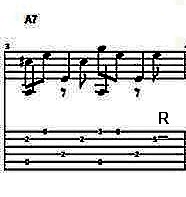
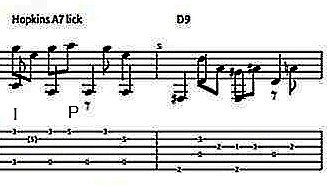
Measure 4:
Beat 1: Now you're in the Hopkins A blues lick. Play 5th and 1st
strings together. Your Index is on the 1st string. Off-beat: Play the Ring
which is on the
2nd string, fifth fret.
Beat 2: 5th and 1st strings again. Off-beat: place Pinky on 1st string fifth
fret, play it.
Beat3: Bass note solo. Off-beat: Remove Pinky and play 1st string with Index
(which
should still be left on it).
Beat 4: 2nd and 5th strings together (still have Ring on 2nd?).
Measure 5: Now make a D9 chord Sat Nite Shuffle,
Come Back Baby)
Beat 1: Just 6th string bass
Beat 2: Alternate bass together with 2nd string third fret. Off-beat:
3rd string. You're already fretting it on the second fret.
Beat 3: 6th and 2nd strings together--notice 2nd string is fretted on 1st fret
here. Off-
beat: Put finger back on 2nd string third fret.
Beat 4: Alternate bass. Off-beat: third string again.
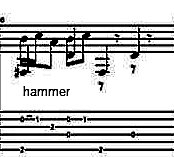
Measure 6:
Beat 1: Quick ham-mer here from open 2nd string to first fret--all at
the same time you're hitting the 6th string bass.
Off-beat: 3rd string.
Beat 2: Pluck alternate bass together with OPEN 2nd string.
Off-beat: replace the finger on the first fret of the 2nd string.
Beat 3: Bass
Beat 4: Alternate Bass.
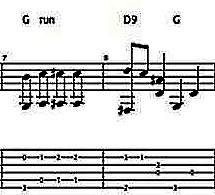
Measure 7: Back to a G here....with some tricks.
Beat 1: 6th and 2nd string together.
Beat 2: Now lift up the chord and fret the 2nd string on the first
fret. Play it simultaneously with the 5th string open.
Beat 3: Now lift this and put Index on 5th string, first fret. At same
time put Middle on 2nd string second fret. Play 'em.
Beat 4: Play these two strings together again.
Measure 8: Make a D9 again.
Beat 1: Play 2nd string third fret together with the 6th string bass. Off-beat:
remove third fret note on 2nd string and play it with the finger that's on the
first fret.
Beat 2: Lift the chord off completely and put Ring on the 3rd string third fret.
Play this
simultaneously with the alternate bass (4th string). Off-beat: Play 2nd
string.
Beat 3: Make a G chord. Play 6th and third strings together.
Beat 4: Play G chord's alternate bass.
That's all, brother.
This is not bad at all.
Sort of your reward for learning the other three (tougher) pieces in
this chapter.
The chord in the second half of measure 7 is really a G diminished
chord. But don't let that worry you--it'll sound good regardless. Just keep
playing it.....
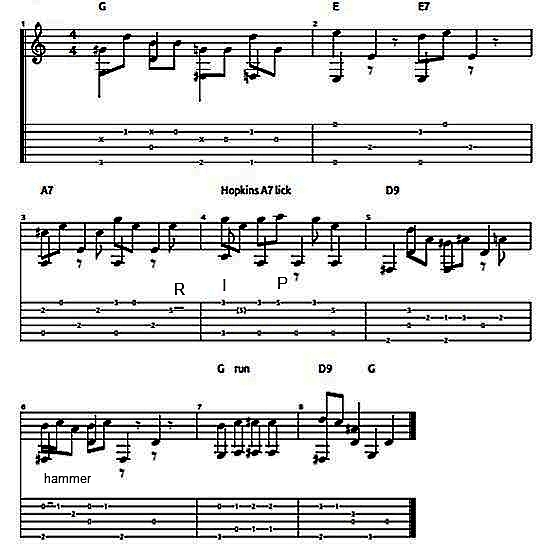
This chapter © 2014 by Andrew D. Polon. All rights reserved.
More info/contact Andy:
www.andypolon.com


























